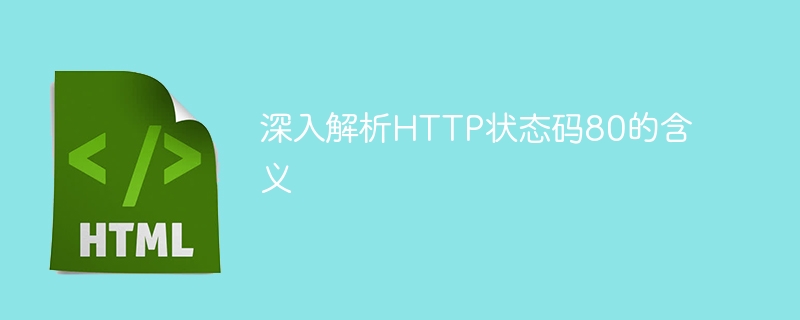

In-depth analysis of the meaning of HTTP status code 80
HTTP (HyperText Transfer Protocol) is an application layer protocol and one of the most widely used protocols on the Internet. During HTTP communication, the server will return a status code indicating the processing result of the request. Status code 80 is one of the HTTP status codes and represents "Moved Permanently", which means permanent redirection.
First, we need to understand what redirection is. Redirection means that when a user accesses a resource, the server will return an indication telling the user that the resource has been moved to another location, and the user will be automatically redirected to the new location to continue accessing. In HTTP, the server uses different status codes to represent different redirection types.
Status code 80 indicates a permanent redirect, that is, the server tells the browser that the requested resource has been permanently moved to another location, and the user should use the new URL to access it in the future. The purpose of this status code is to help search engines and other users update the original URL so that they can find and access new resources.
When the browser receives status code 80, it will automatically send a request to the new URL based on the new URL returned by the server. This means that status code 80 not only tells the user that the resource has been moved, but also tells the browser to use the new URL to access it in the future.
One feature of permanent redirection is that the search engine will replace the original URL with a new URL and update its index so that users can find the resource. In other words, the search engine will transfer the weight of the original URL to the new URL. This is why when we search the original URL in a search engine, the search results show the new URL.
So, under what circumstances will permanent redirection occur? The most common situation is when the website changes its domain name or URL structure. For example, the original website was "www.example.com", but now it is changed to "www.newexample.com". To maintain user and search engine traffic, the server returns status code 80 and provides a new URL.
In addition to changing the domain name, the website may also use permanent redirection when the path or file name is changed. For example, the original URL is "www.example.com/article/123", but now the article is migrated to "www.example.com/blog/post/123". The server will return status code 80 and provide the new URL in the response.
It is very important for developers to understand and correctly use status code 80. First of all, when refactoring the website, changing the domain name, or adjusting the URL structure, we should use status code 80 to maintain user and search engine access traffic. Secondly, when the server returns a new URL, it should ensure that the new URL is correct and can be accessed normally.
To summarize, HTTP status code 80 represents a permanent redirect. When the website needs to change the domain name, adjust the URL structure, or change the file path, the server will return status code 80 and provide a new URL. The purpose of this status code is to help search engines and users update the URL and maintain the continuity of access traffic. Proper use of status code 80 can effectively manage website redirects and protect the user and search engine access experience.
The above is the detailed content of Explore the explanation of HTTP status code 80. For more information, please follow other related articles on the PHP Chinese website!




